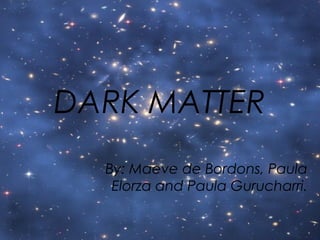
Dark matter
- 1. DARK MATTER By: Maeve de Bordons, Paula Elorza and Paula Gurucharri.
- 2. • • • • -Definition -Interesting Facts -Other theories -News on Dark matter-How close are we to finding dark matter?
- 3. Definition: • Dark matter is a type of matter hypothesized in astronomy and cosmology to account for a large part of the mass that appears to be missing from the universe. • Dark matter cannot be seen directly with telescopes; evidently it neither emits nor absorbs light or other electromagnetic radiation at any significant level.
- 4. Interesting facts: • When the universe was still young clumps of dark matter have likely attracted gas, which then coalesced into stars that eventually assembled the today's galaxies. • Black holes absorb dark matter, and over the billions of years since galaxies were first formed, this absorption of dark matter in black holes has very likely altered the population of galaxies from what we can observe today. • Despite the recent improvement in astronomy, there is still a great deal of unknown about origin, properties and distribution of dark matter in the universe.
- 5. • Dark matter is an misterious energy that contains most of the Universe's mass. This concept was used for the first time by Fritz Zwicky in 1933. • The density of the dark matter in a galaxy has its maximum in the center and it gradually decreases as it gets to the outermost part, but the same process significantly increases the total size of the galaxy. • Determining the nature of dark matter is one one of the most important challenges in cosmology that attracts many scientists.
- 6. • Dark matter makes up roughly 85 percent of the matter in the universe. • Methods for detecting dark matter include direct and indirect detection methods, which cannot be directly observed since it does not emit radiation. • Direct methods: simultaneous light and heat detection, simultaneous heat and ionization detection, and simultaneous light and ionization detection, such as research into distinctive signals (the most famous being the search for an annual modulation in the dark matter signal caused by the orbiting of the Earth). Indirect detection methods: do not directly seek the dark matter particles but researchers try to identify other particles, (neutrinos, photons, etc.), produced when the Universe's dark matter particles are destroyed.
- 7. OTHER THEORIES • Some Researchers in Chile believe that dark matter isn´t existent based on studies they have done, they believe the fact that galaxies ( like the milky way) move is because of another form of gravitation. • Empty Space Filled With "Virtual" Particles theory by Hajdukovic
- 8. • The quantum vacuum is the name physicists give to what we see as empty space. • Antimatter particles are mirror opposites of normal matter particles. For example, an antiproton is a negatively charged version of the positively charged proton, one of the basic constituents of the atom. • When matter and antimatter collide, they clash in a flash of energy. The virtual particles spontaneously created in the quantum vacuum appear and then disappear so quickly that they can't be directly observed. • In yhis new mathematical model they investigate what would happen if virtual matter and virtual antimatter were not only electrical opposites but also gravitational opposites—an idea some physicists previously proposed. • "Mainstream physics assumes that there is only one gravitational charge, while I have assumed that there are two gravitational charges," Hajdukovic said. • That would mean matter and antimatter are gravitationally repulsive, so that an object made of antimatter would "fall up" in the gravitational field of Earth, which is composed of normal matter.
- 9. How close are we to finding dark matter? • Dark matter makes up about a quarter of the cosmos, but we still don't know what it is. As part of a two-part series called Light & Dark on BBC Four, physicist Jim Al-Khalili pondered how close we are to understanding the mysterious "dark stuff".
- 10. • Dark matter is one of the greatest mysteries in the cosmos , an invisible substance thought to make up five-sixths of all matter in the universe. The scientific consensus right now is that dark matter is composed of a new type of particle, one that interacts very weakly at best with all the known forces of the universe, except gravity. As such, dark matter is invisible and nearly completely intangible, mostly only detectable via the gravitational pull it exerts.
- 11. • Given all the progress made in modern physics over the past century, you may be forgiven for thinking that physicists are approaching a complete understanding of what makes up everything in our Universe. • For example, all the publicity surrounding the discovery of the Higgs boson last year seemed to be suggesting that this was one of the final pieces of the jigsaw :that all the fundamental building blocks of reality were now known. • So it might come as something of a shock to many people to hear that we still don't know what 95% of the Universe is made of.
- 12. • The problem with dark matter is that, whatever it is made of, it seems to interact very weakly with normal matter. This makes it very hard to catch like trying to catch a shadow • There are three different ways we can try to find out what dark matter is made of. We can look out into space and see the results of collisions of dark matter particles by trying to detect the normal matter particles created in the debris of these collisions; or we can try to catch dark matter particles directly as they stream through the Earth; or we make them ourselves in particle accelerators like the Large Hadron Collider at Cern.